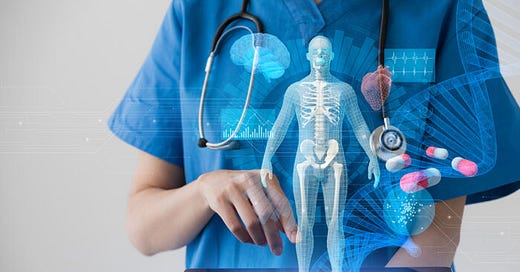Imagine you're a med student on rounds. Your attending pulls up an AI-generated radiology report complete with confidence levels, clinical recommendations, and highlighted areas of concern. It’s not the future, it's happening now.
So what does that mean for you, a future doctor still grinding through prereqs or applications?
📊 Where AI Is Already Being Used in Medicine
In diagnostics, AI algorithms are proving to be powerful tools. They can analyze a wide range of medical images, such as X-rays, MRIs, ultrasounds, CT scans, and DXA scans, to help healthcare providers detect and diagnose diseases faster and more accurately. Beyond imaging, AI systems are capable of processing vast amounts of patient data, including 2D and 3D medical imaging, bio-signals like ECG, EEG, and EMG, as well as electronic health records (EHRs), vital signs (e.g., temperature, pulse, respiration rate, and blood pressure), demographic information, medical history, and laboratory test results. This comprehensive data analysis can support more informed and timely clinical decision-making.
Open Evidence can serve as a valuable second opinion, especially in complex or uncertain cases, prompting clinicians to reflect more critically on their decisions. “How could I be wrong? What am I missing? What other questions should I ask?” says Isaac Kohane, chairman of Harvard Medical School’s Department of Biomedical Informatics. “These are the kinds of prompts that, according to psychological research, complement and enhance the way humans think.”
David Bates, co-director of the Center for Artificial Intelligence and Bioinformatics Learning Systems at Mass General Brigham, sees AI as a powerful opportunity to make medicine safer. A recent study found that roughly one in four hospital visits in Massachusetts results in some form of harm, often due to adverse drug events. AI has the potential to detect medication-related issues with far greater accuracy than traditional methods.
However, Bates also notes a key concern: “AI has a tendency to hallucinate, and that is a worry, because we don’t want things in people’s records that aren’t really there.”
One emerging application is ambient documentation systems. These tools can listen to patient visits, capture everything said and done, and generate structured clinical notes in real time. Physicians can then review and verify the summary for accuracy. This technology has the potential to significantly reduce the burden of documentation, a leading contributor to physician burnout (Harvard Gazette, 2025).
🎓 AI in Medical Education
Pros:
Adaptive learning platforms (like AMBOSS or Anki tools)
Simulated patient encounters with AI chatbots
AI-generated practice questions, tutoring, or even “digital anatomy labs”
Cons:
There’s a risk that future physicians may lose opportunities to develop critical skills through hands-on experience
Another pressing issue is the pervasive bias in biomedical data. Much of modern biomedicine is rooted in colonial histories and shaped by research conducted in wealthy Western nations, often by white men studying populations that look like them. This legacy continues to influence which bodies and experiences are centered in medical knowledge today (Harvard Gazette, 2025).
💡 Skills to Start Building Now
Data Literacy: Basics of interpreting health data, understanding biases in AI models
Digital Health Fluency: Understanding how apps, devices, and decision tools work in the clinic
Curiosity + Adaptability: You don’t need to code, but you should know what AI can and can’t do
📈 Why This Actually Gives You an Edge
Premeds/young docs are digital natives — your comfort with tech is an advantage
Opportunities to stand out: Research in AI, innovation programs, digital health clubs
Employers, residencies, and med schools are starting to value tech-forward thinkers
🔮 What Kind of Doctor Do You Want to Be in 2030?
AI won’t replace doctors, but doctors who use AI will have the edge. You don’t have to be a computer scientist. Just stay curious, flexible, and future-ready.
“Medicine is no longer just about memorizing. It’s about synthesizing, applying, and collaborating — with humans and machines.”
If you haven’t already, check out:
Medical Charting UNLOCKED
Hello! Below is the link to the comprehensive guide: Medical Charting UNLOCKED which will be very beneficial for beginner scribes and medical assistants!






